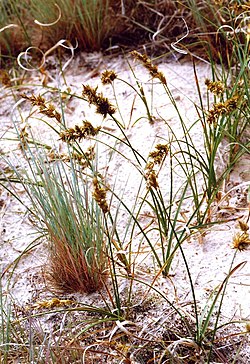| Carex arenaria | |
|---|---|
 | |
| Scientific classification | |
| Kingdom: | Plantae |
| Clade: | Tracheophytes |
| Clade: | Angiosperms |
| Clade: | Monocots |
| Clade: | Commelinids |
| Order: | Poales |
| Family: | Cyperaceae |
| Genus: | Carex |
| Subgenus: | Carex subg. Vignea |
| Section: | Carex sect. Ammoglochin |
| Species: | C. arenaria |
| Binomial name | |
| Carex arenaria | |
Carex arenaria, or sand sedge, is a species of perennial sedge of the genus Carex which is commonly found growing in dunes and other sandy habitats, as the species epithet suggests (Latin arenarius , "sandy"). It grows by long stolons under the soil surface.